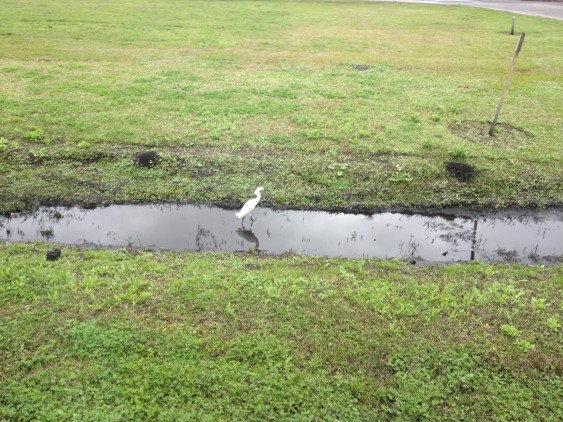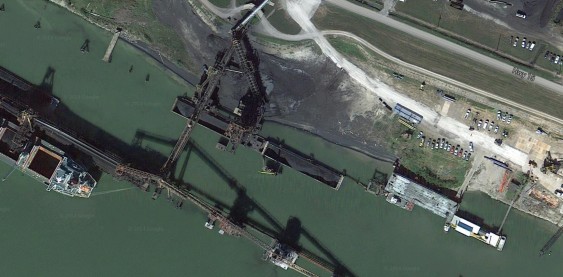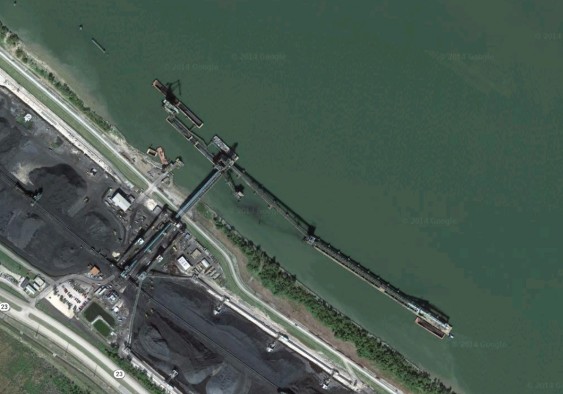I returned from a recent visit to the southern tip of Louisiana with a newfound appreciation for how important it is to prevent coal exports in the Northwest. The two Mississippi River coal facilities there—United Bulk Terminals and Kinder Morgan—are filthy, and plainly degrading nearby communities. Worse yet, another coal terminal, called RAM, is seeking permission to develop along the same stretch of the river.
Now comes news from the New Orleans Times-Picayune that local environmental groups are bringing a lawsuit against United Bulk on the grounds that it has repeatedly violated the US Clean Water Act. Click on that link and you’ll find glaring photographic evidence of coal and coal dust spilling into the Mississippi from the coal-loading equipment.
Here’s a photo I took of a snowy egret in a ditch near the United Bulk Terminals site. The water it’s standing in is literally black with coal contamination.
Predictably, the coal terminal operators complain that they’re somehow being treated unfairly. They claim to have spent tens of millions of dollars on modernizing the facility. But in some ways, their protestations are all the more damning because they demonstrate simply that coal terminals are almost always nasty and polluting neighbors.
It’s exactly what Sightline has found when examining coal dust complaints at terminals in Alaska, northern British Columbia, southern BC, Louisiana, South Carolina, Virginia, Australia, India, and South Africa. It’s the same story everywhere.
On some level, it’s all just painfully obvious. Here’s what Google Earth shows at the United Bulk Terminals. (Click the caption to explore the map interactively.)
There’s coal piled or spilled down to the river’s edge where it is bleeding into the water.
And just across the river, here’s a Google Earth image of the Kinder Morgan coal facility. You can see coal dust trailing into the river from the loading equipment.
Despite plain evidence of coal pollution on site—see images from the Gulf Restoration Network here, here, and here—not to mention dust spreading into communities at least a mile away, Kinder Morgan wants permission to expand its operations there.
The Louisiana lawsuit is not, ultimately, a story about the health of the Mississippi. It’s a story of an industry that will not—or perhaps cannot—operate without pollution and environmental degradation.
And it’s a story of a possible future: it’s what Puget Sound and the Columbia River could look like if the coal export boosters get their way.












Jessie Dye
Thank you for going to the Southern tip of Louisiana on the Mississippi River to write this article for us. The egret in the coal-black water is a heartbreaking visual. Your powerful research and stories about coal export facilities around the world reminds me that our opposition to coal export here is not only about keeping Washington clean, but about protecting all of Creation.
Earl I. White
Eric,
Another well researched article. This is pretty well standard today. These corporations come in with these energy proposals and promise all kinds of things to mitigate the impact. The state or local authorities OK the facility and then ignore it. There is no oversight and the locals are ignored. Then if you want them stop the pollution, they threaten to leave.
Earl White
Marian Gillis
Seeing is Believing. These are good images showing what is planned for Washington.
I saw what they did to “Almost Heaven” West Virginia– and now they are moving to undo this beautiful ecosystem in the PNW.
This is a no brainer that effects us all.
Ted E
On the South side of the river some of the barges appear to have covers but on the north side they don’t, maybe that’s something the trains need to consider. Both facilities seem to have black streams in the water where there appears to be work going on.
A very interesting and scary report.